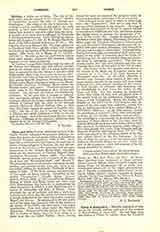

Cyrrhus, a titular see of Syria. The city of the same name was the capital of the extensive district of Cyrrhestica, between the plain of Antioch and Commagene. The origin of the city is unknown; according to a false tradition, it was said in the sixth century to have been founded by Cyrus, King of Persia; this, however, was only a play upon the name. It became at an early date a suffragan of Hierapolis in Provincia Euphratensis. Eight bishops are known before 536 (Lequien, II, 929; E. W. Brooks, The Sixth Book of the Select Letters of Severus, II, 341). The first was present at Nica in 325. The most celebrated is Theodoret (423-58), a prolific writer, well known for his role in the history of Nestorianism and Eutychianism. (His works are in Migne, P.G., LXXXLXXXIV.) He tells us that his small diocese (about forty miles square) contained 800 churches, which supposes a very dense population.
At Cyrrhus a magnificent basilica held the relics of SS. Cosmas and Damian, who had suffered martyrdom in the vicinity about 283, and whose bodies had been transported to the city, whence it was also called Hagioupolis. Many holy personages, moreover, chiefly hermits, had been or were then living in this territory, among them SS. Acepsimas, Zeumatius, Zebinas, Polychronius, Maron (the famous patron of the Maronite Church), Eusebius, Thalassius, Maris, James the Wonderworker, and others. Theodoret devoted an entire work to the illustration of their virtues and miracles. The city was embellished and fortified by Justinian. At the same time it became an independent metropolis, subject directly to Antioch. The patriarch, Michael the Syrian, names thirteen Jacobite bishops of Cyrrhus from the ninth to the eleventh century (Revue de l’Orient chretien, 1901, p. 194). Only two Latin titulars are quoted by Lequien (III, 1195). The site of the city is marked by the ruins at Khoros, nine miles northwest of Kilis, in the vilayet of Aleppo; these ruins stand near the river Afrin Marsyas, a tributary of the Orontes), which had been banked up by the aforesaid Theodoret.
S. VAILHE

